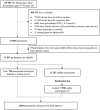Linking Creatinine-to-Body Weight Ratio With Diabetes Incidence: A Multiethnic Malaysian Cohort Study
- PMID: 39843936
- PMCID: PMC11753918
- DOI: 10.1111/1753-0407.70039
Linking Creatinine-to-Body Weight Ratio With Diabetes Incidence: A Multiethnic Malaysian Cohort Study
Abstract
Background: Emerging evidence suggests that the creatinine-to-body weight (Cre/BW) ratio is a predictor for incident diabetes in the Asian population. This study examined the association between Cre/BW ratio and incident diabetes, as well as the relationship between Cre/BW ratio and skeletal muscle and body fat mass in a multiethnic Malaysian cohort.
Methods: A total of 13 047 eligible participants were selected from 119 560 The Malaysian Cohort participants. Of these, 750 who developed diabetes were selected as cases, while 3750 controls were chosen randomly from healthy participants. This nested case-control study included 4500 eligible participants from The Malaysian Cohort, with a 1:5 case-to-control ratio. Participants were stratified into four groups based on Cre/BW ratio quartiles. The Cox proportional hazards model evaluated the effect of Cre/BW ratio on developing incident diabetes. The association between Cre/BW ratio and body composition was assessed using the Pearson correlation coefficient.
Results: Of the 13 047 eligible participants followed up over 5.3 years, 5.75% (n = 750) developed diabetes. Diabetes incidence decreased with increasing Cre/BW ratios. The Cre/BW ratio was inversely correlated with diabetes risk (HR: 0.403, 95% CI: 0.315-0.515, p < 0.001). Additionally, males and Indians had a higher risk of developing incident diabetes. A significant correlation was observed between Cre/BW ratio and body fat mass (p < 0.001).
Conclusions: This study reveals an inverse association between the Cre/BW ratio and incident diabetes. It also found a significant moderate correlation between the Cre/BW ratio and body fat mass.
Keywords: body fat mass; body weight; creatinine; diabetes; multiethnic population.
© 2025 The Author(s). Journal of Diabetes published by Ruijin Hospital, Shanghai Jiaotong University School of Medicine and John Wiley & Sons Australia, Ltd.
Conflict of interest statement
The authors declare no conflicts of interest.
Figures





Similar articles
-
The association between creatinine to body weight ratio and the risk of progression to diabetes from pre-diabetes: a 5-year cohort study in Chinese adults.BMC Endocr Disord. 2023 Dec 4;23(1):266. doi: 10.1186/s12902-023-01518-9. BMC Endocr Disord. 2023. PMID: 38044422 Free PMC article.
-
Relationship between creatinine to body weight ratios and diabetes mellitus: A Chinese cohort study.J Diabetes. 2022 Mar;14(3):167-178. doi: 10.1111/1753-0407.13248. Epub 2022 Jan 10. J Diabetes. 2022. PMID: 35001531 Free PMC article.
-
Creatinine-to-body weight ratio is a predictor of incident diabetes: a population-based retrospective cohort study.Diabetol Metab Syndr. 2022 Jan 15;14(1):7. doi: 10.1186/s13098-021-00776-8. Diabetol Metab Syndr. 2022. PMID: 35033175 Free PMC article.
-
Behavioral and Pharmacotherapy Weight Loss Interventions to Prevent Obesity-Related Morbidity and Mortality in Adults: An Updated Systematic Review for the U.S. Preventive Services Task Force [Internet].Rockville (MD): Agency for Healthcare Research and Quality (US); 2018 Sep. Report No.: 18-05239-EF-1. Rockville (MD): Agency for Healthcare Research and Quality (US); 2018 Sep. Report No.: 18-05239-EF-1. PMID: 30354042 Free Books & Documents. Review.
-
Diabetes as a risk factor for tuberculosis disease.Cochrane Database Syst Rev. 2024 Aug 23;8(8):CD016013. doi: 10.1002/14651858.CD016013.pub2. Cochrane Database Syst Rev. 2024. PMID: 39177079 Free PMC article.
References
-
- International Diabetes Federation , ed., IDF Diabetes Atlas, 10th ed. (Brussels: International Diabetes Federation, 2021).
-
- World Health Organization , “W. Diabets Fact Sheet,” 2021, https://www.who.int/news‐room/fact‐sheets/detail/diabetes.
-
- National Institute of Health Malaysia , “Non‐Communicable Diseases: Risk Factors and Other Health Problems (NHMS 2019),” Vol 1, 2020, http://www.iku.gov.my/nhms‐2019.
MeSH terms
Substances
Grants and funding
LinkOut - more resources
Full Text Sources
Medical

